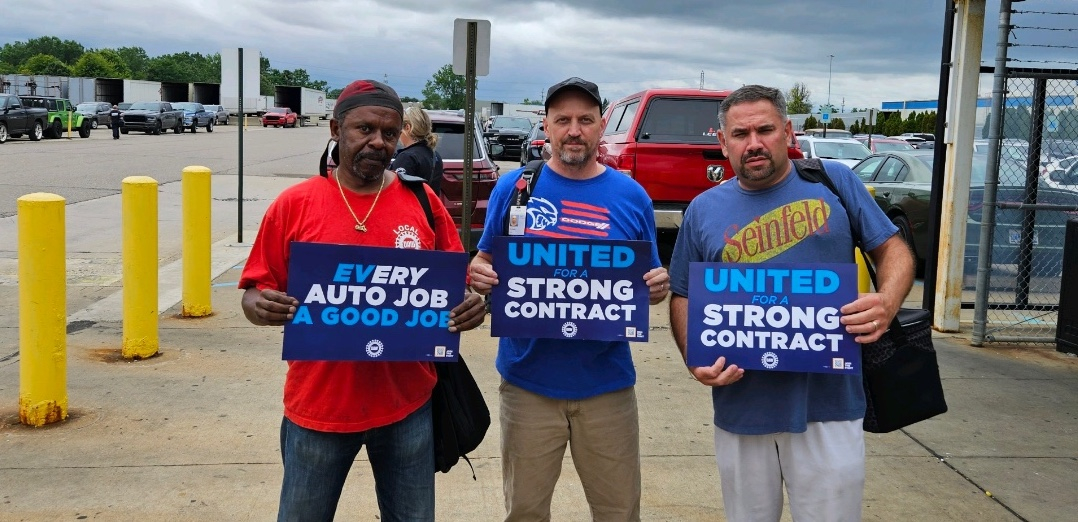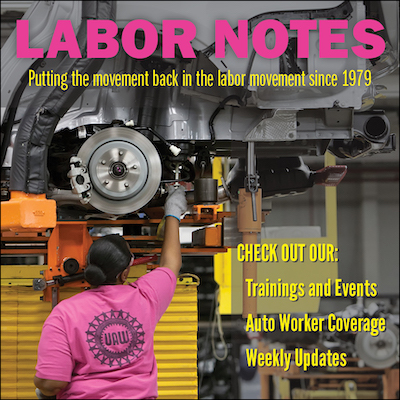Steward’s Corner: Ten-Minute Meetings

Members of Auto Workers Local 1264 in Sterling Heights, Michigan, held signs as part of the ongoing contract campaign in at the Big 3 automakers. Ten-minute meetings are part of the toolkit UAW members are using to gear up for a possible strike after the contract expires September 14. Photo: UAW.
As auto workers prepare for the expiration of the Big 3 auto contracts covering 150,000 members September 14, some are turning to a valuable tool they saw UPS Teamsters use: the 10-minute meeting.
It’s simply an in-person meeting with your co-workers that is just 10 minutes long—and which, crucially, is held at work. Instead of scheduling a long meeting offsite on off-time, you’re bringing the meeting to them, and making it as convenient as possible.
Ten-minute meetings can update members on negotiations and important actions during a contract campaign. Leading up to the UPS expiration, for example, Teamster activists held brief parking lot meetings right before or after their shifts. These meetings were large, building widespread solidarity and strike-readiness.
UPS got the message. Managers saw workers doing highly visible actions like parking lot rallies and marching at practice pickets, and gave in to almost every key Teamster demand.
BREAK ROOM MEETINGS
Chris Budnick has been holding 10-minute meetings at Ford’s Kentucky Truck Plant in Louisville to get his co-workers talking to each other about the Big 3 contracts.
Like many activists, Budnick says he has long struggled to get his co-workers interested in what’s going on in the union. Attendance at meetings at the union hall lagged. But he knew that interest in negotiations was at an all-time high, with members emboldened by new reform leaders at the top and with ending two-tier, cost of living raises, and the electric vehicle transition at stake.
So Budnick decided to set up a short meeting in the break room of the stamping department—and it was an immediate hit. Sixteen co-workers came to the first 10-minute meeting; to the second, 22. Now they’re all asking when the next meeting will be.
Budnick kept the agenda simple, following a sample outline from Unite All Workers for Democracy (UAWD), the reform caucus that Budnick co-chairs. First, he gave a brief update on Big 3 contract negotiations, with the rest of the time on discussion and Q&A. He passed out strike buttons and reminded everyone it was time to get serious about “Red Shirt Wednesdays,” the Auto Workers’ longstanding solidarity tradition.
Budnick said it’s the most engaged he has ever seen his co-workers: “People want to talk about the contract and they come with a lot of questions, but they aren’t usually given the opportunity to discuss it in a group. They want to know what’s going on and get involved, but they don’t know how.”
The meetings have also been a boost to morale on the shop floor. One disaffected long-time member of the local, frustrated after feeling ignored by union leadership for years, is coming because “the meetings are finally giving him hope.”
Budnick expanded the meeting to other departments and shifts in subsequent weeks.
Budnick has found that these short meetings strengthen the contract campaign the UAW has launched across the Big 3, along with frequent communications to members from UAW President Shawn Fain and the International.
Ten-minute meetings can be used during any stage of workplace organizing, from encouraging turnout to a rally or a practice picket to contract enforcement or organizing around local issues. “Even though we were mainly talking about the national contract, people also kept bringing up issues specific to our plant,” said Budnick. “There is a lot of hunger to talk it out.”
START SMALL
The secret to 10-minute meetings is to start small. “Start where you can organize and work your way up,” says Budnick.
Anyone can run a 10-minute meeting. You don’t need to be a steward or an elected leader (although involvement from leaders can help). Team up with a co-worker to run your first meeting, if you can.
How to prepare:
- Make a short agenda. Don’t go overboard, and keep the focus on practical topics. Spend a minute welcoming everyone or recapping last week’s meeting, then a minute or two introducing the discussion topic (such as a workplace issue or contract negotiations), followed by five minutes for discussion and questions, and then wrap up, reminding people to bring co-workers to the next meeting.
- Decide where and when to hold the meeting. Possible spaces could be the parking lot, a break room, or an on-site classroom or conference room. Hold it on break, during lunch, or before or after a shift change.
- Invite your co-workers—and steadily grow attendance. For your first meeting, you might start by inviting just three to five co-workers, and getting a commitment from them to come. Your goal should be to increase attendance steadily every week—and to make sure you reach new hires, part-timers, and any marginalized groups within your workplace.
Tips to increase attendance:
- Have a brief face-to-face conversation with each person you’re inviting (only call or text to invite them if absolutely necessary). Don’t just invite; make sure to ask if they can commit to being there.
- Map the departments and shifts in your workplace—how can you get the people who are missing to come?
- Swing by their work area or text them a reminder before the meeting begins.
- Give everyone who comes a homework assignment: to bring one to two co-workers to the next meeting.
At the meeting:
- Set a timer for 10 minutes. Stick to the agenda, and stop when the timer goes off.
- Create a sign-in sheet for contact information (particularly phone numbers).
- Stumped by a question? You don’t need to know all the answers. Encourage discussion and collective problem-solving—it’s a union meeting, not your meeting.
- Follow up and prepare for the next meeting. Put the new contacts from your sign-in sheet into your phone. Make a spreadsheet, on paper or digital, and add to it as you go. Look over your list. Who stands out as someone who could help run the next meeting, or get more involved? Who didn’t make it, and why?
The key to expansion is to always be thinking about who else you can bring into planning and facilitating the meetings. You may need to provide some reassurance.
“A lot of people feel they don’t know enough to help run a meeting, but I remind them that they don't need to be an expert or know the answers to all questions,” said Budnick.
KNOW YOUR RIGHTS
Management—and sometimes even the leadership of your union—may be freaked out to see workers gathering and actually talking together at work—imagine! But your right to hold a meeting in the workplace is protected by federal law.
The National Labor Relations Board says that “your employer cannot prohibit you from talking about or soliciting for a union during non-work time, such as before or after work or during break times; or from distributing union literature during non-work time, in non-work areas, such as parking lots or break rooms.”
The right of union members to freely associate with one another, regardless of what position you hold in the union, is guaranteed by the Labor-Management Reporting and Disclosure Act, which states that “every member of any labor organization shall have the right to meet and assemble freely with other members.”
Thinking about holding a 10-minute meeting in your workplace? Budnick’s final piece of advice: “Don’t be afraid. You’re going to be nervous. Just do it!”
See how to hold a 10-minute meeting at UAWD.org. Includes training video.







